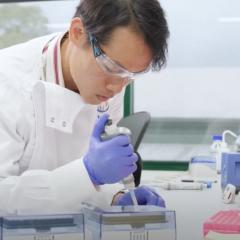Laboratory testing should be part of screening for trachoma in remote Australian communities to avoid unnecessary antibiotic treatment and further screening, according to University of Queensland researchers.
The call follows a study by researchers at the UQ Centre for Clinical Research (UQCCR) that investigated trachoma, a bacterial eye infection that can cause irreversible blindness. Trachoma is strongly associated with poverty, and is linked to social inequalities, an ongoing legacy of colonisation in First Nations populations.
Lead researcher and UQ PhD candidate Ms Kathleen Lynch, who is also a clinical nurse consultant in Queensland Health’s Communicable Diseases Branch, said the study examined three cross-sectional screening surveys conducted during 2019–2021.
“Researchers compared the results of standard clinical assessments with complementary clinical and laboratory methods to determine if community-wide treatment for trachoma was needed in a remote Queensland community. Children aged 1–14 years were screened, along with opportunistic screening of people aged 15 years and older.
“Across the three surveys, we performed 73 trachoma examinations of 58 children aged 1-4 years old, 309 examinations of 171 children aged 5-9 years old, 142 examinations of 105 children aged 10–14 years, and 171 examinations of 164 people aged 15 years and older” Ms Lynch said.
“Of the total 695 examinations conducted, 691 were of Aboriginal or Torres Strait Islander people (99%), and 337 were girls or young women (48%).
“Clinical signs consistent with early stages of trachoma were identified in 5–9-year-old children 23 times (7%), including in 11 with non-chlamydial infections and one with a C. trachomatis infection,” Ms Lynch said.
“One child, aged between 10–14 years, met the criteria for trachomatous scarring. Two of 272 conjunctival swab samples taken across all ages were positive for C. trachomatis (0.7%). Two people aged over 40 years had trichiasis, a painful condition where eyelashes grow inward, and a total of 14 children tested positive for anti-Pgp3 antibodies in blood samples.”
Although trachoma may have once been endemic in the remote Queensland community examined, the study shows this is no longer the case.
Ms Lynch said, as a result of this work and previous research undertaken in Queensland, the National Trachoma Surveillance and Control Group has endorsed discontinuing further routine screening in this community,” she said.
“In fact, following this work and our Torres Strait Islands investigation, routine public health screening for trachoma is no longer required in any Queensland community.
“These findings will also have implications for how trachoma screening is conducted, and progress monitored, for the elimination of trachoma in other parts of Australia and the world.
“We have shown that detailed clinical examinations, PCR testing and anti-Pgp3 antibody assessments can benefit routine public health surveys and should be included in national guidelines for eradicating trachoma in Australia.”
This research is published in the Medical Journal of Australia. (DOI: 10.5694/mja2.51735)



